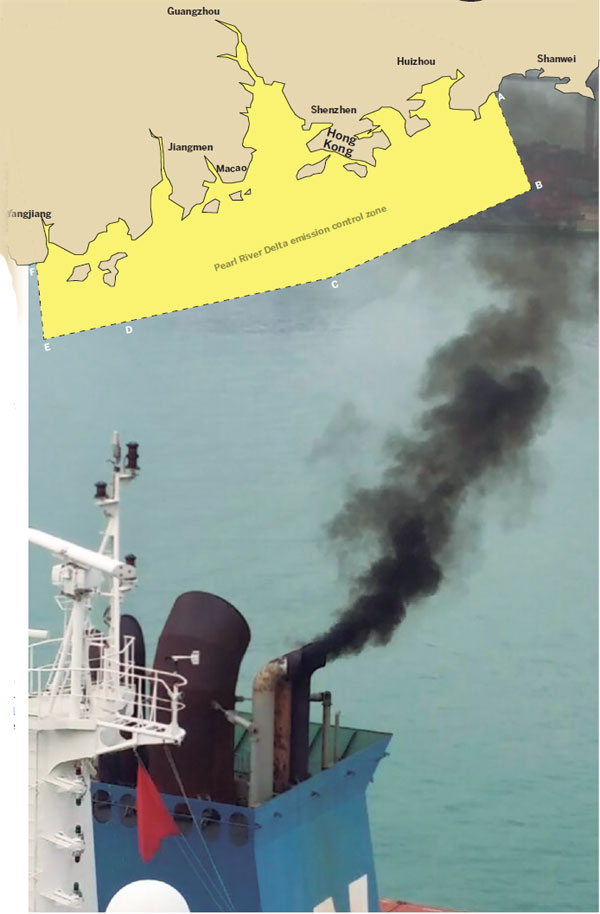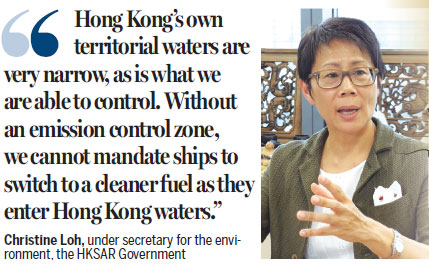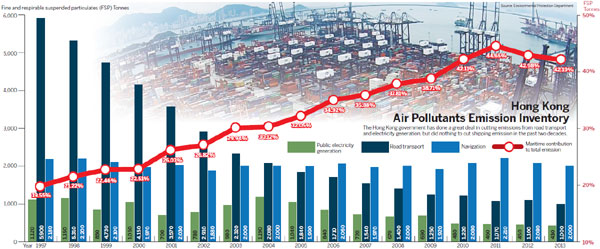Fuelling a low-emission target
Updated: 2016-05-23 07:14
By Andrea Deng(HK Edition)
|
|||||||||
HK is part of a pilot national plan to reduce pollution from berthing vessels. Experts, however, doubt if there might be sufficient supply of low-sulfur fuel to meet that end. Andrea Deng reports.
Hong Kong leads Asia in reducing deaths linked to ship emissions by putting sulfur caps on marine fuels, yet the city lags behind Western standards in pushing forward stricter regulations.
Cutting down shipping emissions matters because it is the biggest source of pollution in Hong Kong, especially after emissions from transport and power generation were reduced substantially.


The southern Chinese city is the most affected location in the busy Pearl River Delta (PRD) region - workshop of the global consumer economy.
An estimated 385 people die annually due to air pollution-related illness. The health of roughly 3.8 million residents living in the city dubbed the "fragrant harbor" is impacted.
Shipping emissions are a cocktail of deadly pollutants including sulfur dioxide which constricts the air passages to one's lung, causing a host of respiratory complications. PM2.5-microscopic dust particles cause cardiovascular and respiratory diseases including lung cancer while nitrogen oxide and ozone reduce lung function.
Children, elderly people and those with respiratory issues are most at risk.
A study was jointly conducted by Hong Kong Polytechnic University, University of Hong Kong and think tank Civic Exchange in 2012 to assess the impact of marine emissions on the health of Hong Kong residents. Researchers found Hong Kong bore the brunt of shipping emissions in the entire PRD. When vessels moving through the region passed through the city, the prevailing winds pushed pollutants across Hong Kong before these could be blown out toward the sea.
The PRD's waters are rarely calm, churned over by a near constant parade of container ships heading for the world's third, fifth and ninth busiest ports of Shenzhen, Hong Kong and Guangzhou. Roughly 376,040 ocean-going vessels plied through the Hong Kong waters in 2015 alone, according to the Marine Department. The majority of these were heading for other ports in the PRD, particularly Shenzhen's Shekou port.
Drastic cuts
Since the past two decades the Hong Kong government has been cutting down pollution from other sources. From 1997 to 2013, PM2.5 emissions from road transport dropped by roughly 80 percent, thanks to tighter regulations on fuel. Less reliance on coal has caused the level of PM2.5 from electricity generation to go down by about 60 percent.
However, during the same period, nothing has been done to tackle shipping emissions, now the biggest polluter in the city. The 2012 study showed nearly three quarters of shipping emission-related premature deaths in the entire PRD region happened in Hong Kong.
Simon Ng, chief research officer of think tank Civic Exchange, said 385 people dying annually from marine emissions was only a conservative estimate. He noted the findings were based on sulfur dioxide emissions and did not factor in PM2.5 levels as these were not readily available and would certainly have raised the number of projected casualties.
"The high number - 3.8 million people being directly affected by shipping pollution - I think, surprised many people. Therefore it gave the drive to us to deal with shipping emissions," Under Secretary for the Environment Christine Loh said, citing the number from the 2012 study.
Three years after Ng's report, the Hong Kong government took the initiative to tackle the dirtiest of ship emissions. A much more ambitious national plan is in the pipeline.
Since July 2015, it's mandatory for all vessels berthed in Hong Kong to switch to fuels five times cleaner than the 2.6 percent sulfur fuel ships would normally use in the open seas. As a result sulfur concentration at ports and surrounding locales was halved between July and December 2015, according to the government's air monitoring stations.
For the rest of Hong Kong an estimated 12 percent reduction of sulfur dioxide and 6 percent reduction of PM2.5 has been observed, a feat Ng called remarkable.
The 0.5 goal
Hong Kong is included in a pilot national plan which will be enforced in phases. The proposed emission control zone will stretch from Bohai Bay in the north to the Yangtze River Delta in the east, and the PRD in the south.
Key ports in the PRD including Shenzhen, Guangzhou and Zhuhai will follow Hong Kong's example and require ocean-going vessels to switch to sulfur fuel not exceeding 0.5 percent while berthed. From January 2018, the policy will extend to all ports in the region and by January 2019 all marine vessels sailing in the PRD emission control zone will have to cruise on fuel with a 0.5 percent sulfur cap.
Ng said 91 percent of premature deaths in Hong Kong linked to shipping emissions would be eliminated once the PRD emission control zone was fully implemented.
Hong Kong-based proponents of the PRD emission control zone will be left holding their breath, until progress is made next door. "Hong Kong's own territorial waters are very narrow as is what we are able to control. Without an emission control zone, we cannot mandate ships to switch to a cleaner fuel as they enter Hong Kong waters," says Loh.
While Hong Kong is a regional leader in cutting shipping emissions, Asia - boasting some of the world's most developed and vibrant economies - lags behind the West which remains years ahead in terms of ship emission reduction regulations, Ng said.
Canada and the United States as well as parts of Europe already have Emission Control Areas, requiring ships to switch to 0.1 percent sulfur fuels, the most stringent regulations on earth.
Following suit in Asia remains impractical without sufficient capacity to produce the 0.1 percent sulfur fuel needed, since the refinery industry has yet to ramp up production of cleaner fuels.
It's the classic chicken and egg conundrum. Regulations will be fought without sufficient supplies of clean fuel to make compliance financially feasible, while little incentive exists to increase production without regulatory pressure.
"We cannot mandate 0.1 percent fuel without being assured that the fuel is available - we're looking into that," Loh said.
"It is possible for Hong Kong to go ahead and say we'll change our law for 0.1 percent fuel. But we're not yet in a position to be assured that there will be sufficient (supplies) for all the vessels that berth in Hong Kong, not just the ones to North America or North Europe."
Hong Kong has always prided itself in its ports. They handle 90 percent of the city's cargo, which accounts for 23.4 percent of the city's GDP from trading and logistics. While the ships destined for the PRD and passing through Hong Kong pay a fee, whether this income is earned at the expense of the citizens' health remains an area of concern.
"We're all affected by the type of fuel the ships are burning and the emissions coming out from the ships. I think the Hong Kong government should go all out and try to do more to reduce shipping emissions," said Ng.
Contact the writer at andrea@chinadailyhk.com

(HK Edition 05/23/2016 page8)